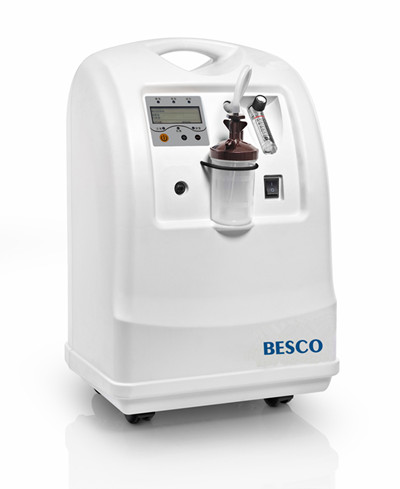| Name: | 5L Oxygen Concentrator |
|---|---|
| Model No.: | BES-OC10 |
| Product Name: | oxygen concentrator |
| Brand: | BESCO |
| Keywords: | Portable Oxygen Concentrators,Oxygen Concentrator for sale,Buy Oxygen Concentrator |
| LEAD TIME: | 10 days |
| Sample: | Available |
| Certificates: | CE,FDA |
| Payment Term: | T/T in advance |
| Country of Original: | China |
| Port: | Shanghai |
| Stock: | Available |
| Factory Address: | Changyuan,China |
| Office: | Zhengzhou,China |
Products Description
5L Oxygen Concentrator
| America imported molecule sift |
| Max.Flow:5L/Min |
| Oxygen density: 93±3% (V/V) |
| Power Consumption:≤480W |
| Noise:≤53dB(A) |
| Continuous Working Time: 10,000 hours |
| N.W.:23/25KGS |
| Carton Size:465*375*655 mm |
| 1PC/CTN |

An oxygen concentrator is a medical device that extracts oxygen from the ambient air, filters out nitrogen and other gases, and delivers it to a user who needs supplemental oxygen for a medical condition. It creates its own oxygen on demand, unlike a compressed or liquid oxygen tank which holds a finite supply. These devices are powered by electricity or batteries and are used for conditions like COPD, cystic fibrosis, and sleep apnea to improve breathing and stamina.
How it works:
1. Intake:
The concentrator takes in ambient air, which is about 79% nitrogen and 21% oxygen.
2. Filtration:
The air passes through a series of filters and sieve materials (such as zeolite canisters) that separate and remove the nitrogen.
3. Oxygen Production:
This process leaves behind purified, medical-grade oxygen.
4. Delivery:
The oxygen is then compressed and sent to the user through a nasal cannula or mask.
Types of oxygen concentrators:
Stationary/Home models:
These are larger, heavier units that provide continuous flow oxygen and are typically plugged into a wall socket.
Portable oxygen concentrators (POCs):
Lighter and smaller than stationary units, POCs can be powered by rechargeable batteries, home electricity (AC), or a car's cigarette lighter socket (DC).
Key differences from oxygen tanks:
On-demand oxygen: Concentrators make oxygen as needed, while tanks store a limited supply that can run out.
Power source: Concentrators require electricity or battery power to operate.
Safety: Concentrators are a safer option than carrying heavy, pressurized tanks.
Important considerations:
Prescription required:
An oxygen concentrator should only be used under the guidance of a doctor, as using one without a prescription can be dangerous.
Settings:
Some models can deliver oxygen continuously, while others offer pulse-dose delivery, which releases oxygen in bursts during inhalation.
Noise:
Oxygen concentrators can be noisy due to their internal mechanisms, though newer models aim to reduce this sound.



